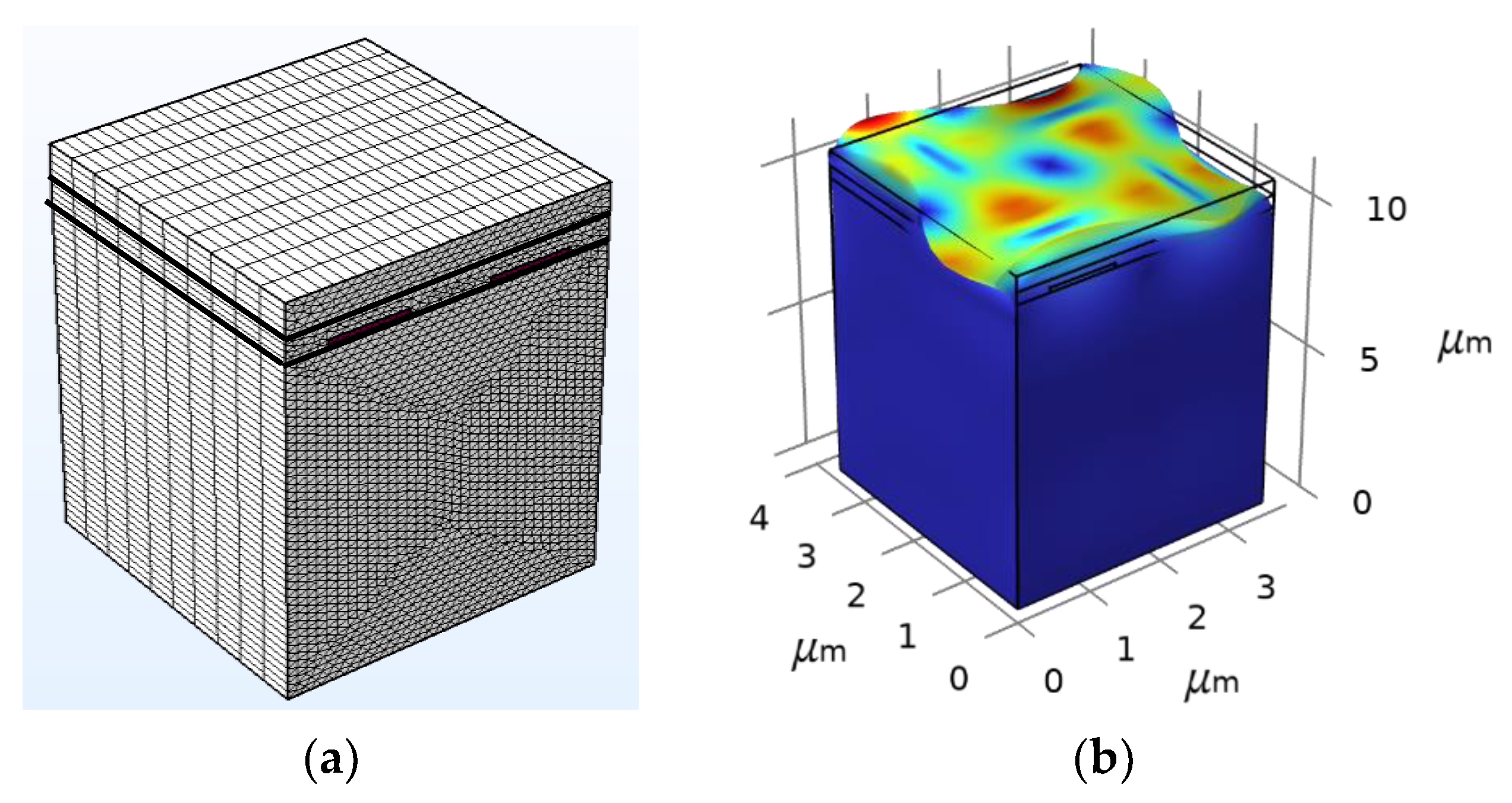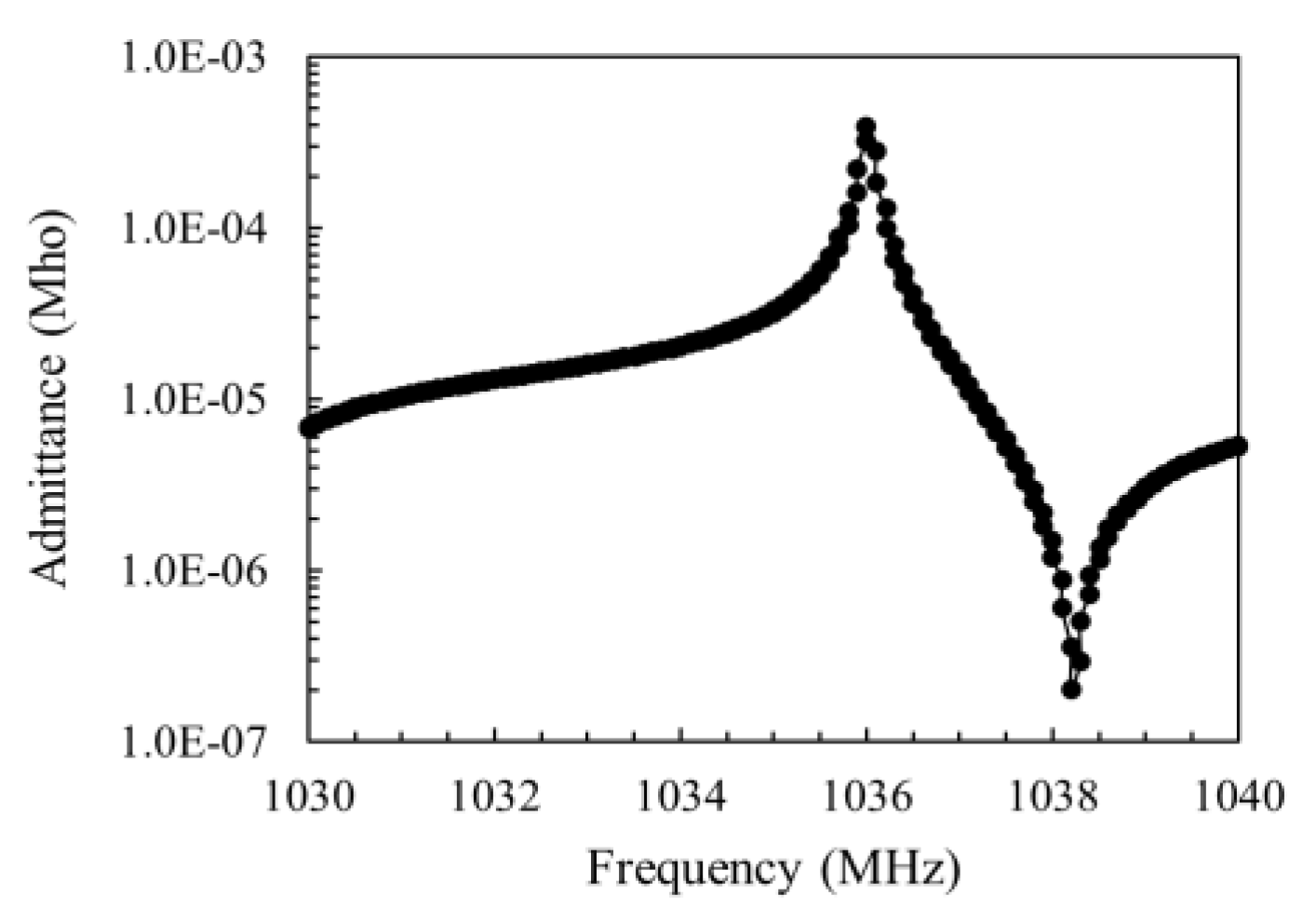Modelling and FEM Simulation of Love Wave SAW-Based Dichloromethane Gas Sensor †
Abstract
:1. Introduction
2. Design Methodology
3. Results and Discussion
4. Conclusions
Author Contributions
Funding
Institutional Review Board Statement
Data Availability Statement
Acknowledgments
Conflicts of Interest
References
- United States Environmental Protection Agency. (An Official Website of United States Govt): Volatile Organic Compounds—Indoor Air Quality. Available online: https://www.epa.gov/ (accessed on 15 May 2022).
- Campbell, C. Surface Acoustic Wave Devices and Their Signal Processing Applications; Elsevier: Amsterdam, The Netherlands, 2012; ISBN 0-12-157345-1. [Google Scholar]
- Matatagui, D.; Fontecha, J.; Fernández, M.J.; Oliver, M.J.; Hernando-García, J.; Sánchez-Rojas, J.L.; Gràcia, I.; Cané, C.; Santos, J.P.; Horrillo, M.C. Comparison of two types of acoustic biosensors to detect immunoreactions: Love-wave sensor working in dynamic mode and QCM working in static mode. Sens. Actuators B 2013, 189, 123–129. [Google Scholar] [CrossRef]
- Kumar, M.; Bhadu, D. Design Performance and Frequency Response Analysis of SAW-Based Sensor for Dichloromethane Gas Sensing Amidst the COVID-19. J. Vib. Eng. Technol. 2021, 9, 725–732. [Google Scholar] [CrossRef]
- Panchal, B.; Varghese, S. 3D FEM Simulation and Analysis of Fractal Electrode-Based FBAR Resonator for Tetrachloroethene (PCE) Gas Detection. Fractal Fract. 2022, 6, 491. [Google Scholar] [CrossRef]
- Ho, C.K.; Lindgren, E.R.; Rawlinson, K.S.; McGrath, L.K.; Wright, J.L. Development of a Surface Acoustic Wave Sensor for In-Situ Monitoring of Volatile Organic Compounds. Sensors 2003, 3, 236–247. [Google Scholar] [CrossRef] [Green Version]
- Gao, L.; Yang, Y.; Gong, S. Wideband Hybrid Monolithic Lithium Niobate Acoustic Filter in the K-Band. IEEE Trans. Ultrason. Ferroelectr. Freq. Control 2021, 68, 1408–1417. [Google Scholar] [CrossRef] [PubMed]
- Hashimoto, K. (Ed.) RF Bulk Acoustic Wave Filters for Communications; Artech House: Norwood, MA, USA, 2009; ISBN 9781596933217. [Google Scholar]
- Moustafa, M.; Laouini, G.; Alzoubi, T. Finite Element Analysis of SAW Sensor with ZnO Substrate for Dichloromethane (DCM) Gas Detection. Arch. Acoust. 2021, 46, 419–426. [Google Scholar] [CrossRef]
- I-STEM. Available online: www.istem.gov.in (accessed on 18 July 2022).
- COMSOL. Available online: www.comsol.com (accessed on 26 June 2021).





| Description | Value |
|---|---|
| DCM concentration in air (mol/m3) | 0.040874 |
| Molar mass of DCM (kg/mol) | 0.08493 |
| PIB/air partition constant for DCM | 30.346 |
| Mass concentration of DCM in PIB (kg/m3) | 0.10534 |
| Circuit Parameters | When DCM = 0 ppm | When DCM = 1000 ppm |
|---|---|---|
| 3.13 × 10−2 | 3.12 × 10−2 | |
| 7.54 | 7.55 | |
| (KΩ) | 10.739 | 5.690 |
| (Ω) | 18.8 | 8.00 |
| 1.625 | 1.62 |
Publisher’s Note: MDPI stays neutral with regard to jurisdictional claims in published maps and institutional affiliations. |
© 2022 by the authors. Licensee MDPI, Basel, Switzerland. This article is an open access article distributed under the terms and conditions of the Creative Commons Attribution (CC BY) license (https://creativecommons.org/licenses/by/4.0/).
Share and Cite
Anoop, A.V.; Panchal, B.; Varghese, S. Modelling and FEM Simulation of Love Wave SAW-Based Dichloromethane Gas Sensor. Eng. Proc. 2022, 27, 27. https://doi.org/10.3390/ecsa-9-13267
Anoop AV, Panchal B, Varghese S. Modelling and FEM Simulation of Love Wave SAW-Based Dichloromethane Gas Sensor. Engineering Proceedings. 2022; 27(1):27. https://doi.org/10.3390/ecsa-9-13267
Chicago/Turabian StyleAnoop, Anchara Veettil, Bhargav Panchal, and Soney Varghese. 2022. "Modelling and FEM Simulation of Love Wave SAW-Based Dichloromethane Gas Sensor" Engineering Proceedings 27, no. 1: 27. https://doi.org/10.3390/ecsa-9-13267
APA StyleAnoop, A. V., Panchal, B., & Varghese, S. (2022). Modelling and FEM Simulation of Love Wave SAW-Based Dichloromethane Gas Sensor. Engineering Proceedings, 27(1), 27. https://doi.org/10.3390/ecsa-9-13267






